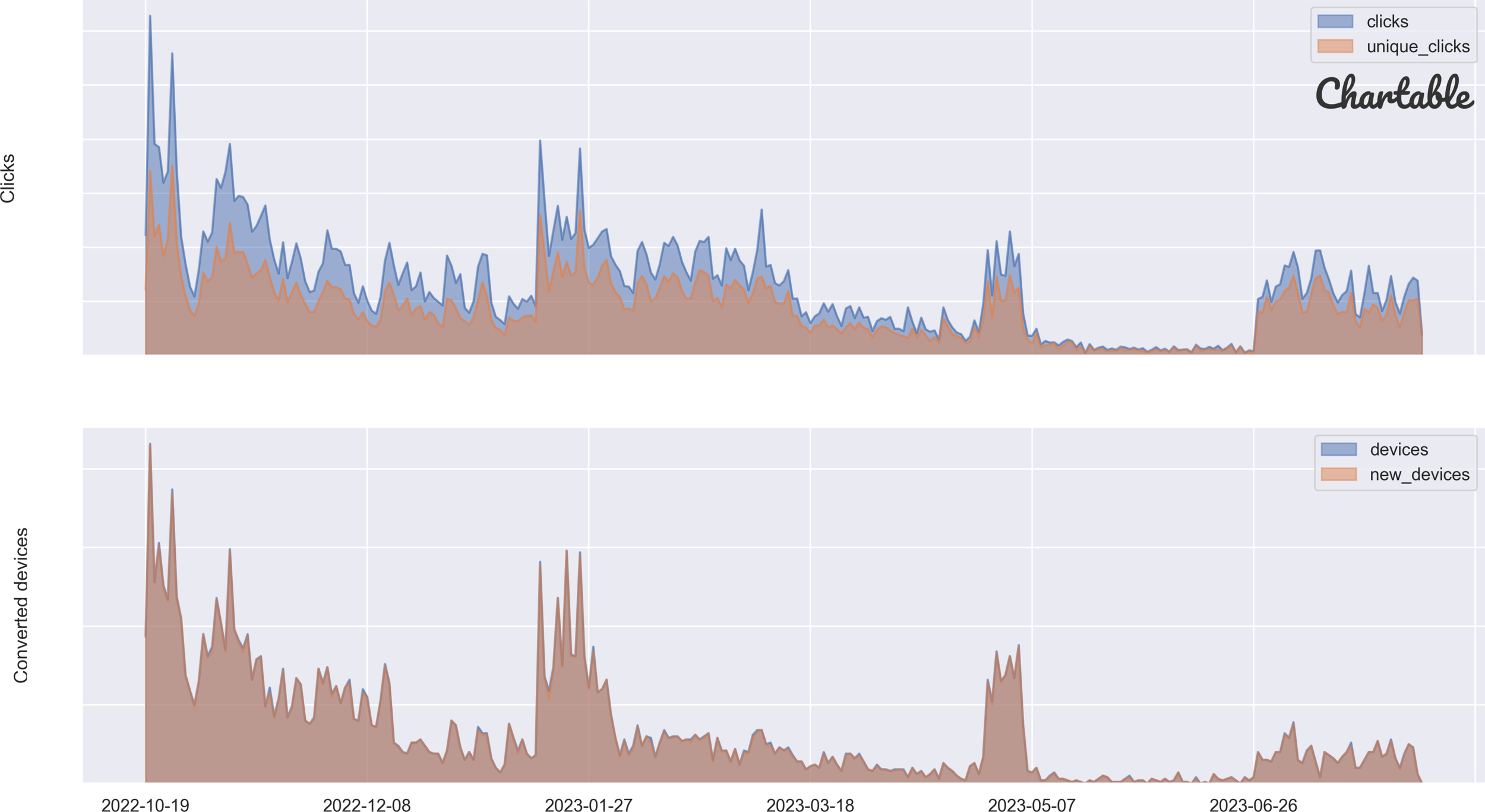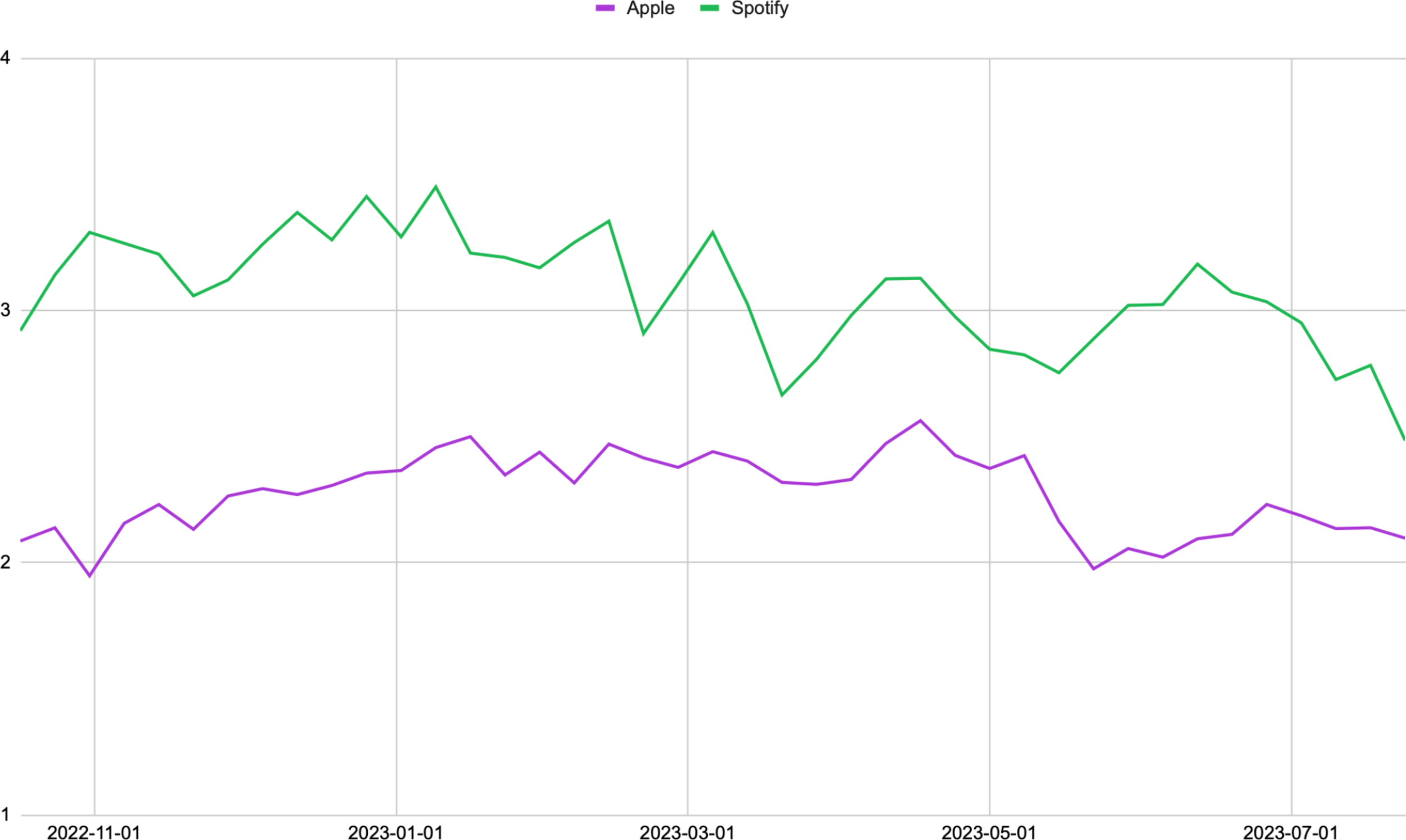Beyond the download: 7 signs of real podcast growth
This is a vital signs monitor. Or, as it’s sometimes called, a “patient monitor” or “bedside monitor.” Healthcare professionals use these devices to monitor a patient’s vital signs: heart rate, blood pressure, body temperature, among others. These devices aren’t meant to replace a patient’s full medical record. Rather, they’re designed to help trained experts see and interpret their patients’ most important medical parameters at a glance.
For a long time, I’ve wanted a vital signs monitor… for podcasts.
Hear me out.
If such a device existed, you could hook it up to your podcast, then be able to see whether your show is healthy. You’d also be able to quickly spot issues and opportunities to intervene.
And that got me thinking. If a podcast vital signs monitor did exist, what exactly would it show on screen? What are the most essential health parameters for podcasters? What’s the podcast equivalent of a heart rate?
I know one thing for sure: any good podcast vital signs monitor would include more than just downloads. At best, downloads paint an incomplete picture of audience growth. At worst, they can mislead and distort podcasters’ understandings of audience size and growth. You wouldn’t assess a patient’s health by their heart rate alone. Why should podcasters only look at a single indicator?
So then, what might a podcast vital signs monitor display?
Here are the 7 signs of podcast audience growth I’d add to mine.
1. Listen Time
For many podcasters, Listen Time is the most important sign of health and audience growth. Listen Time is the total amount of time your audience spends with your episodes, aggregated across every podcast listening platform. Unlike downloads, Listen Time measures actual consumption.
I’ve written before about how and where to get Listen Time data, and about the different ways to use Listen Time to measure your podcast audience’s attention. At the show level, the most useful way to visualize this is by looking at Listen Time over time – by day, week, or month.
If the cumulative amount of time your audience spends with you is growing week over week, month over month, consider it a healthy sign. If your downloads spike but your Listen Time stays flat, are you really growing?
2. Release Cadence and Back Catalog Depth
It’s hard to grow without releasing new episodes. Some of the most successful shows I’ve worked on are built on consistency. That means showing up regularly for your listeners. It means fitting into your listeners’ lives, habits, and routines. Episode after episode. As Seth Godin says: drip, drip, drip.
Up First is a part of my morning routine. Their consistency is astounding:
Erika Kullberg launched Erika Taught Me in late 2022, and her publishing schedule has been incredibly consistent ever since:
Some shows are are organized into seasons, with significant quiet periods in between. This can be a very effective strategy, but it’s important to temper audience growth expectations during the fallow periods:
Whenever I start working with a new show, I always look at their historical release cadence. Often, it’s obvious when they started to get serious, because you can see it reflected in their historical release patterns:
Releasing new episodes is the heartbeat of your show.
Also, by releasing consistently, you build up your back catalog, increasing the surface area for discovery through search, and giving new listeners opportunities to dive deep into your back catalog.
Yesterday at the airport, I overheard a Welcome to Night Vale fan describing the show to their travel companions. “You have to listen from the beginning. I’m on episode nineteen,” they exclaimed, taking a dramatic pause while scrolling on their phone, “…of two hundred and thirty two!”
3. Marketing attribution
If your audience isn’t growing, here are a few good questions to ask:
What have we done to encourage prospective listeners to try our show?
Are we telling the right people about our show, in the right way, at the right time?
When we tell people about our show, do they take action? Do they sample?
Thankfully, tools exist to help answer these questions. Spotify-owned Chartable offers SmartLinks and SmartPromos. Podscribe offers similar measurement tools, and Apple just announced an integration with Linkfire for Podcasts.
Here’s some Chartable SmartLink data from a Bumper client:
On the top, we see the total number of clicks to a clickable or tappable Chartable SmartLink. Below, we can see the number of converted devices that resulted from those clicks.
This is a great way to gauge both the volume and effectiveness of podcast marketing, especially across owned, rented, and paid channels. The total number of clicks is a way to make sure you don’t take your foot off the gas. And the ratio of clicks to converted devices is a way to gauge how effective your marketing is.
These types of tools are an important part of the podcast marketing toolkit, and they’re worth paying close attention to. They’d definitely get a spot on my podcast vital signs monitor.
4. Listeners
Anytime you see the word “listeners” it’s important to disambiguate. As Jonas wrote:
Most podcast hosting platforms provide listener numbers in addition to download data. The Interactive Advertising Bureau (IAB) even has a standard definition for the term “listener“.
However, it is important to note that the “listeners” or “unique listeners” numbers provided by hosting platforms do not measure the number of people who have actually listened to an episode of your show. Instead, you get a count of unique IP addresses and user-agent strings that have downloaded – not necessarily listened to – your podcast.
So when podcast hosting companies talk about “listeners,” they’re almost always talking about “downloaders”.
When I say “listener” here, I am not talking about the IAB’s definition. Rather, I’m talking about what some people in our industry call “verified listeners” – user accounts or device IDs where we know someone has actually hit a play button and spent time with an episode.
Dashboards like Apple Podcasts Connect and Spotify for Podcasters can report on listeners by day, week, and month. This is important because we’re counting people (or close proxies), and we need to deduplicate across time. If I listen to 5 episodes of a show in a week, I should only count as one weekly listener.
Here’s how I like to display daily, weekly, and monthly listeners:
For many shows, this is a far superior way to measure the true size of your audience than simply counting downloads. Downloads don’t tell you if anyone actually listened. Listeners tell you that.
Measure listeners. And please, be careful with that word, because different people mean very different things when they use it.
5. Average episodes per listener per week or month
This vital sign is possible because publisher dashboards like Apple Podcasts Connect and Spotify for Podcasters offer daily, weekly, and monthly listener numbers at both the episode and series level.
As an example, let’s look at a Bumper client with a show that releases three episodes per week.
Anecdotally, we know some listeners will listen to every single episode released in that week. They may even dip into the back catalog and check out older episodes.
Some other listeners may only listen to one episode per week.
Average episodes per listener per week or month is a powerful derived metric because it can help podcasters understand how “sticky” their show is, and how that stickiness may be changing over time. Here’s what that looks like for one of Bumper’s clients:
Most weeks, the average Apple Podcasts listener to this show consumes 2 to 2.5 episodes per week. That’s pretty great for a show that releases 3 episodes per week.
The number is even higher on Spotify. In fact, some weeks, the average number of episodes per listener is greater than the number of episodes released that week, which could suggest strong activity on the back catalog.
If your show has a regular release cadence, pay close attention to these numbers over time. They can tell you a lot about the stickiness of your show. They’re also a powerful way to gauge your marketing activities. If you send a large amount of qualified traffic to your show, these numbers should stay flat, or even increase.
However, if you send a large amount of unqualified traffic to your show – perhaps through an attempt to buy followers or chart position – those unqualified listeners will push the average down.
Bumper tracks average episodes per listener per week or month for our clients, and I think any podcaster with a regular release cadence should too.
6. Followers
Followers matter because they indicate listeners opting in. Perhaps a listener has sampled an episode, and they want to be notified about new episodes. Maybe a friend recommended your show to them, and they’re using the follow button as a kind of bookmark to easily come back to your show later.
Follows are a useful growth signal, and they tend to move alongside other measures. Here’s how we like to look at them:
At the top, we see all time cumulative followers across Apple and Spotify. Below, we see daily changes. Looking at both together offers helpful context, especially for shows with large existing audiences.
For example, on this chart, we can clearly see period starting in mid-May 2023 where we started gaining a lot of followers on a daily basis. That just so happens to line up with an Apple Podcasts editorial feature. In fact, this increase in Apple Podcasts followers was part of how we learned this show was featured by Apple’s editorial team.
7. Downloads
Last but not least, it’s the audience growth metric everyone’s obsessed with, despite the fact that it can be manipulated, relies on automatic downloads that may never be heard, is susceptible to bugs in listening apps, and has no agreed-upon technical standard (NB: a set of guidelines does not make a standard).
Despite all this, downloads are an important unit of measure for many advertising sales teams. I’m not suggesting podcasters should ignore downloads. Of course not. But downloads are, at best, an imperfect way to measure audience size, and they shouldn’t be the only measure of podcast audience growth.
A word on fragmentation
I’ve outlined 7 signs of audience growth that Bumper watches closely for our clients:
Listen Time
Release cadence and back catalog depth
Marketing attribution
Listeners
Average episodes per listener
Followers
Downloads
Podcasters have never had better access to audience growth measurement. At the same time, measurement fragmentation means it’s never been more difficult to see the whole picture. To closely monitor podcast health, podcasters might need to check several different dashboards on a regular basis.
To stay on top of all these numbers, a podcaster would have to regularly check Apple Podcasts Connect, Spotify for Podcasters, their hosting provider, one or more third-party attribution services like Chartable or Podscribe, etc. No single dashboard lets podcasters touch the entire elephant.
I began this post by describing my desire for a kind of “podcast vital signs monitor.” Here at Bumper, we couldn’t find one that suited our needs.
So we’re building one. Here’s a sneak peek:
I’ll share more details about The Bumper Dashboard at Podcast Movement 2023 during my session Beyond the download: 7 signs of real growth that podcasters should start measuring today.
We’re currently trialling our dashboard with Bumper clients. To find out more, sign up to our newsletter to be notified:











